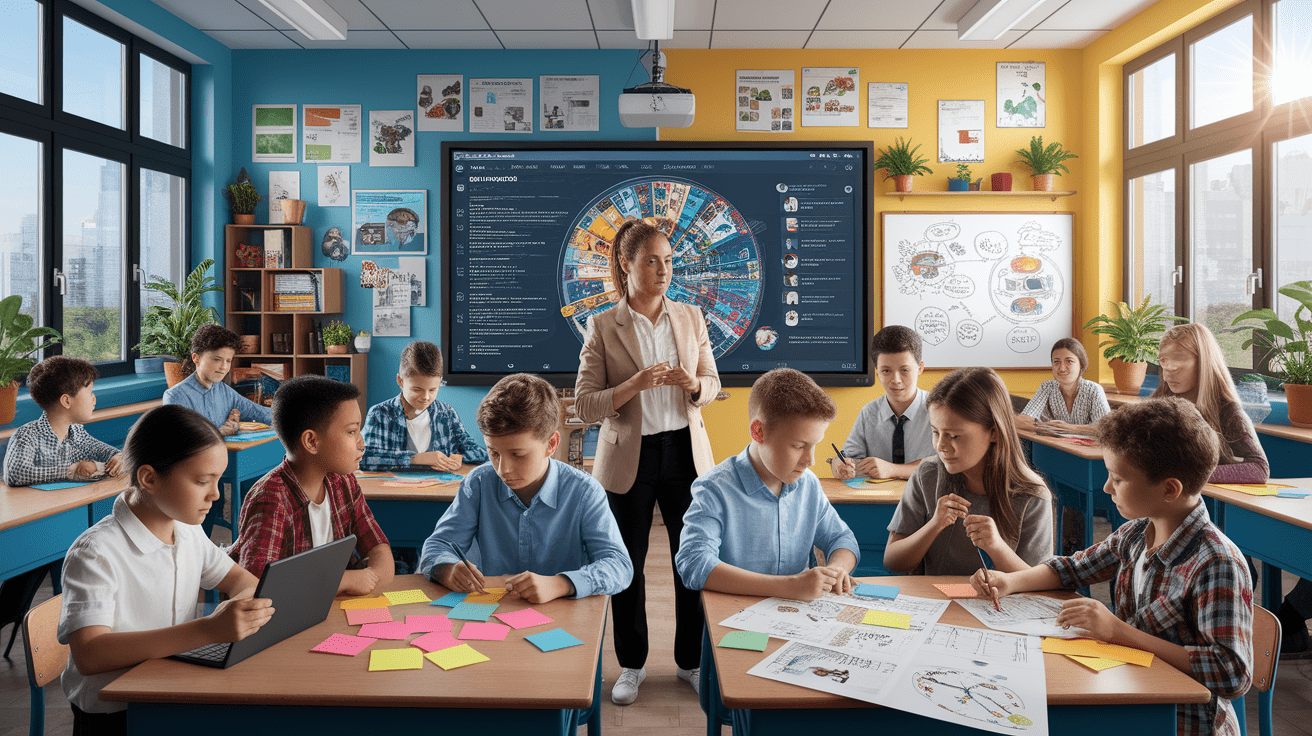Picture this: You’re halfway through your carefully crafted math lesson when you notice half your students staring blankly while the other half are already done and looking bored. Sound familiar? Welcome to the beautiful chaos of teaching! The good news? You don’t need to throw your lesson plan out the window—you just need to flex it like a yoga instructor.
Teaching with a flexible framework means maintaining your learning goals while being ready to pivot your methods faster than a basketball player avoiding a defender. It’s about responsive teaching that meets students where they are, not where we think they should be.
Flex Your Lesson from the Jump
Let’s be honest—rigidity is the enemy of great teaching. When we cling too tightly to our plans, we miss the magic moments where real learning happens. The flexible framework is your teaching superpower, allowing you to maintain firm learning goals while offering multiple pathways for students to reach success.

Think of effective lesson plans as your GPS navigation system. You know your destination (learning objectives), but when there’s traffic ahead (student confusion) or a road closure (unexpected challenges), you need alternative routes ready to go.
This approach isn’t about lowering standards or “winging it”—it’s about smart instructional design that anticipates learner variability. Whether you’re working with English Language Learners (ELLs), gifted students, or those with specific learning disabilities, flexibility ensures every student has a pathway to success.
Why Flexibility Matters More Than Ever
Today’s classrooms are wonderfully diverse, with students bringing different backgrounds, learning styles, and needs. A one-size-fits-all approach simply doesn’t cut it anymore. When we plan for unexpected student needs in a lesson, we’re not just being prepared—we’re being equitable.
Research shows that when teachers use real-time adjustments based on student feedback, engagement skyrockets and learning outcomes improve significantly. It’s like being a detective and a magician rolled into one!
Pillars of the Flexible Framework
The flexible framework stands on three rock-solid pillars that will transform how you approach dynamic instruction. Let’s dive into each one and see how they work together to create classroom magic.

Goal Consistency, Method Variability
This is where the rubber meets the road in flexible teaching. Your lesson rationale should clearly establish firm, standards-aligned objectives—these are your non-negotiables. For example, “Students will mentally calculate 10 more/less than a two-digit number” remains constant whether students use manipulatives, draw pictures, or work through verbal problems.
The magic happens in your methods. Embed diverse tools, strategies, and choices into your lessons from the start. Think step-by-step guides for your sequential learners, visual models for your picture-thinkers, and tiered tasks that challenge every level. This isn’t just good differentiated instruction strategies—it’s pedagogical genius!
Differentiation and Engagement
Here’s where Universal Design for Learning (UDL) principles shine brightest. Your lessons should incorporate multiple entry points—visual, auditory, and tactile—because your students’ brains are as unique as their fingerprints.
Create adjustable challenges that can scale up or down on the fly. When you notice your advanced learners zipping through problems, have extension activities ready. When struggling students hit a wall, have simplified versions waiting in the wings. This reduces barriers for those who need support while extending opportunities for those ready to soar.
Responsive Assessment
Formative assessment is your secret weapon for knowing when and how to adapt. Think of it as your teaching radar system—constantly scanning for understanding (or confusion) and informing your next moves.
Use quick strategies like exit tickets, peer discussions, thumbs up/down checks, or simple observation to gauge comprehension mid-lesson. When you see those glazed-over looks or confused expressions, that’s your cue to shift gears. Assessment for learning isn’t just about grades—it’s about guidance.
Strategies for On-the-Fly Lesson Adaptation
Ready to become a lesson adaptation ninja? These strategies will help you respond to student needs in the moment during instruction without missing a beat.

The Explicit-Model-Release Power Play
This three-step dance is perfect for adapting teaching methods based on student confusion during a lesson. When students aren’t getting it, slow down and break it down:
- Explicit Instruction: Crystal-clear explanations with no assumptions
- Modeling: Show them exactly how it’s done (think-alouds are gold here)
- Release of Responsibility: Gradually hand over the reins with scaffolding
The beauty of this approach? You can cycle back to any step based on what your students need. Seeing confusion during independent practice? Loop back to modeling. Students racing ahead? Fast-forward to release.
Quick Ways to Adjust Lesson Activities for Struggling Students
When you need to pivot fast, try these classroom-tested strategies:
- Chunk and Check: Break complex tasks into smaller, manageable pieces
- Partner Power: Pair struggling students with peer mentors
- Choice Boards: Let students pick their path to demonstrate understanding
- Think-Pair-Share: Give processing time before jumping into discussions
- Anchor Charts: Create visual reminders of key concepts on the spot
How to Differentiate Instruction on the Fly During a Lesson
Understanding the four phases of a lesson plan helps you identify exactly where adaptations can happen. During the exploration phase, you might shift from individual work to collaborative groups. In the explanation phase, you might add visual supports or real-world connections.
Keep these differentiation tools in your back pocket:
- Content: Adjust complexity, add context, or provide background knowledge
- Process: Change grouping, pacing, or instructional strategies
- Product: Offer different ways to show learning (verbal, visual, kinesthetic)
Tools and Resources to Support Flexibility
Even superheroes need their gadgets! These tools will help you build flexibility into your lesson planning process and support student-centered learning.

Digital Game-Changers
Technology can be your flexibility friend when used strategically:
- Kahoot or Nearpod: Real-time formative assessment that shows you exactly who gets it
- Padlet or Jamboard: Collaborative spaces for sharing ideas and checking understanding
- Flipgrid: Voice and video responses for different expression styles
- Choice boards on Google Slides: Pre-made options for quick pivots
Low-Tech, High-Impact Solutions
Don’t forget about the simple tools that pack a punch:
- Exit Tickets: Quick pulse checks on understanding
- Red/Yellow/Green Cards: Instant visual feedback on comfort level
- Think-Pair-Share Protocols: Built-in processing time and peer support
- Flexible Seating: Physical environment changes that support different needs
Pre-Planning for Flexibility
Smart teachers know that flexibility starts in the planning phase. Create “Plan B” options for each major lesson component. Have extension activities ready for early finishers and support materials available for struggling learners.
Consider creating a “flexibility toolkit” with laminated choice boards, manipulatives, and quick reference sheets that you can grab at a moment’s notice.
Real Classroom Scenarios
Let’s get real about what flexible teaching looks like in action. These scenarios will help you see how to manage classroom behavior while adapting your lesson and ensure all students benefit from lesson adaptations.
Scenario 1: The Mixed-Signal Math Lesson
The Situation: You’re teaching fraction addition, and you notice three distinct groups: students who are breezing through, others who are completely lost, and a few who understand but are making careless errors.
The Flex Response: Instead of pushing forward, create three stations: a challenge station with complex word problems for your advanced learners, a review station with manipulatives and visual fraction bars for struggling students, and a practice station with guided problems for those who need reinforcement. Rotate every 15 minutes based on student needs.
Scenario 2: The ELL Reading Challenge
The Situation: During a literature discussion, your English Language Learners are struggling with vocabulary and cultural references while native speakers are ready for deeper analysis.
The Flex Response: Pair ELL students with bilingual peers for vocabulary support while providing advanced students with analytical thinking prompts. Use visual aids and graphic organizers to support comprehension, and allow students to share insights in their comfort zone—whether that’s writing, drawing, or verbal discussion.
Scenario 3: The IEP Accommodation Moment
The Situation: A student with an Individualized Education Program (IEP) is having a particularly challenging day, and your planned independent work session isn’t going to work.
The Flex Response: Quickly shift to a collaborative model where this student can work with a supportive peer. Modify the task to focus on fewer problems with extended time, and provide the sensory break or movement opportunity outlined in their Behavior Intervention Plan (BIP) if needed.
Scenario 4: The Gifted Student Dilemma
The Situation: Your gifted students finished the main activity in half the time and are starting to distract others.
The Flex Response: Have them become peer tutors, work on an independent extension project, or tackle a completely different challenge problem that connects to the same learning objective. Turn their quick understanding into a teaching opportunity for everyone.
The Flex Finale: Bringing It All Together
Congratulations! You’re now equipped with the mindset, strategies, and tools to transform your classroom into a flexible learning environment where every student can thrive. Remember, flexible teaching isn’t about being unprepared—it’s about being so well-prepared that you can adapt to anything.
Your Action Plan
Start small and build your flexibility muscles gradually:
- Week 1: Focus on formative assessment—add one quick check-in to each lesson
- Week 2: Prepare one “Plan B” option for your most challenging lesson
- Week 3: Try the Explicit-Model-Release approach with a difficult concept
- Week 4: Experiment with choice boards or tiered assignments
Remember the Why
When you embrace the flexible framework, you’re not just adapting lessons—you’re adapting to humans. Every pivot you make, every real-time adjustment, every moment you choose responsiveness over rigidity, you’re telling your students that their learning matters more than your plan.
Teaching with flexibility takes practice, patience, and a willingness to embrace the beautiful unpredictability of learning. But the rewards—engaged students, improved outcomes, and the joy of watching every learner succeed—make every adaptation worth it.
Now go forth and flex those lessons! Your students are counting on you to meet them where they are and take them where they need to go. You’ve got this!




